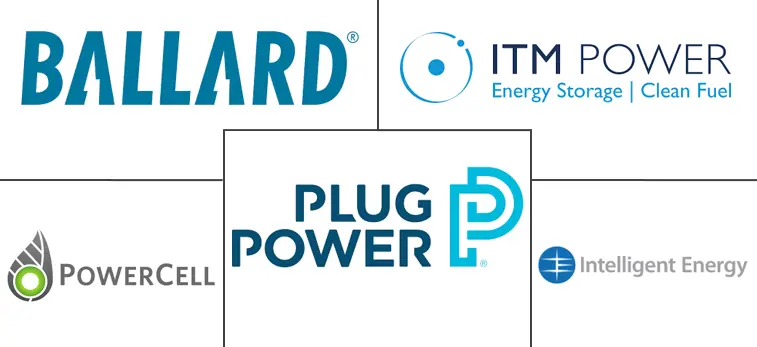Polymer Electrolyte Membrane Fuel Cells (PEMFCs) Market Size and Share
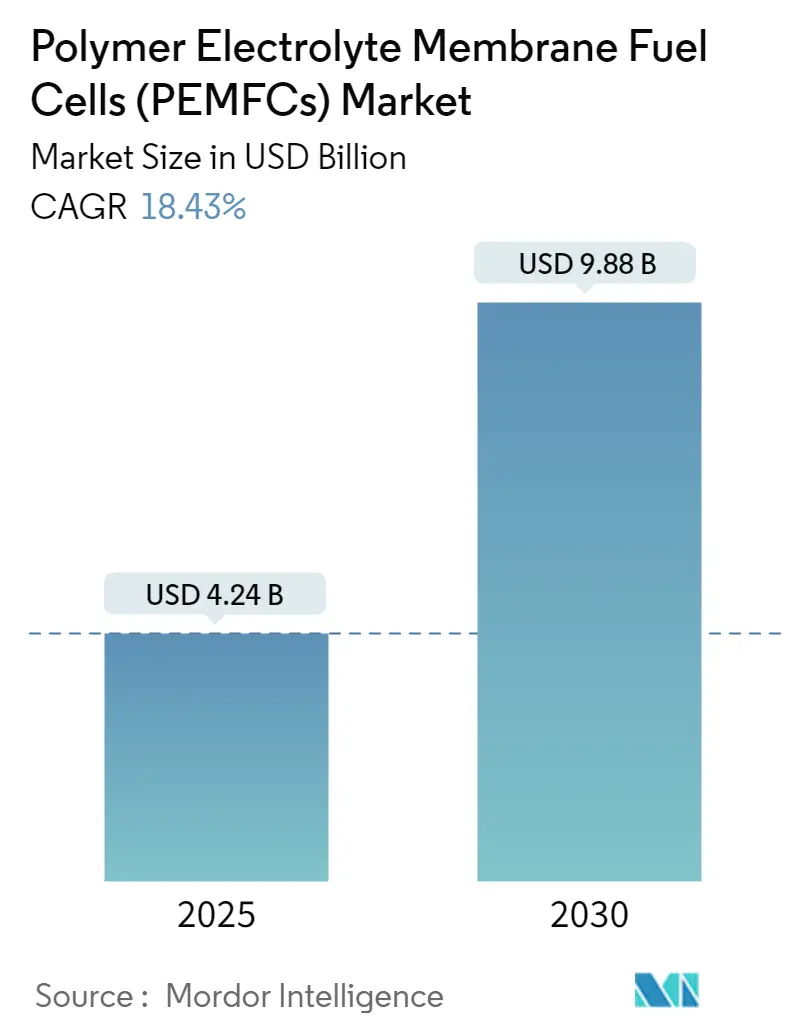
Polymer Electrolyte Membrane Fuel Cells (PEMFCs) Market Analysis by Mordor Intelligence
The Polymer Electrolyte Membrane Fuel Cells Market size is estimated at USD 4.24 billion in 2025, and is expected to reach USD 9.88 billion by 2030, at a CAGR of 18.43% during the forecast period (2025-2030).
Though COVID-19 negatively impacted the market in 2020, it has reached pre-pandemic levels.
- Major factors driving the market are increasing research & development (R&D) activities in the field of fuel cells, which has led to several technological advantages, such as high power density, less time to refuel, more extended storage durability, and more number of life-cycles of polymer electrolyte membrane fuel cells over its alternatives, such as Li-ion battery. This has been driving the adoption of polymer electrolyte membrane fuel cell-powered vehicles and is thus expected to drive the market during the forecast period.
- However, the current high cost of polymer electrolyte membrane fuel cell technology and the availability of other viable energy systems in the market is expected to hinder the market growth during the forecast period.
- The technological advancements in PEMFCs, such as reducing the share of platinum in the fuel cell, which in turn decreases its final cost, are expected to create several opportunities in the market during the forecast period.
- The Asia-Pacific dominated the global polymer electrolyte membrane fuel cells market in 2022, with China holding a significant share. The major factors attributing to the growth are the policies initiated by various governments in countries such as China and Japan to drive the use of clean energy.
Global Polymer Electrolyte Membrane Fuel Cells (PEMFCs) Market Trends and Insights
Government Initiatives and Growing Private Investments are Expected to Drive the Market
- The PEM fuel cell market witnessed significant growth in the last two years, mainly due to the introduction of government initiatives in key markets and increasing investment support from the private sector.
- The Californian Energy Commission's Alternative and Renewable Fuel and Vehicle Technology Program, a government initiative in 2013, established long-term authority to co-fund the first 100 retail hydrogen stations. This encouraged the private sector to invest in the fuel cell market.
- The Californian Fuel Cell Partnership aims for a network of 1,000 hydrogen stations and a fuel cell vehicle population of up to 1,000,000 vehicles by 2030. The target reflects the input and consensus of more than 40 partners, including fuel cell technology companies, automakers, energy companies, government agencies and non-governmental organizations, and universities.
- In February 2022, a project showed that high-temperature polymer electrolyte membrane fuel cells (HT-PEMFCs) offer an attractive solution to electrify heavy-duty vehicles and other large-scale mobility applications due to effective heat rejection.
- Moreover, multiple institutions, including LANL (Katie Lim), Sandia National Labs (Cy Fujimoto), Korea Institute of Science and Technology (Jiyoon Jung), University of New Mexico (Ivana Gonzales), University of Connecticut (Jasna Jankovic), and Toyota Research Institute of North America (Zhendong Hu and Hongfei Jia) were involved in this project.
- Among fuel cells, the PEM type is the most popular one. It is expected to play a crucial role in Europe's target for fuel cell deployment and drive the PEM fuel cells market.
- In February 2022, scientists of the Los Alamos National Laboratory developed a new polymer fuel cell that operates at higher temperatures. The long-standing issue of overheating, one of the biggest technical obstacles to using medium- and heavy-duty fuel cells in vehicles, such as trucks and buses, was resolved by a new high-temperature polymer fuel cell that operates at 80-160 degrees Celsius and has a higher rated power density than cutting-edge fuel cells.
- Furthermore, there is a rise in fuel cell-based vehicle demand worldwide. North Korea and the United States are the leading countries in the world in terms of stock of fuel cell-based vehicles. In 2021, North Korea and the United States had 38% and 24% of world fuel cell-based vehicle stock, respectively.
- Hence, such government initiatives and investments are likely to propel the market during the forecast period. Therefore, owing to the abovementioned factors, government initiatives and growing private investments in PEMFC technology are expected to drive the market during the forecast period.
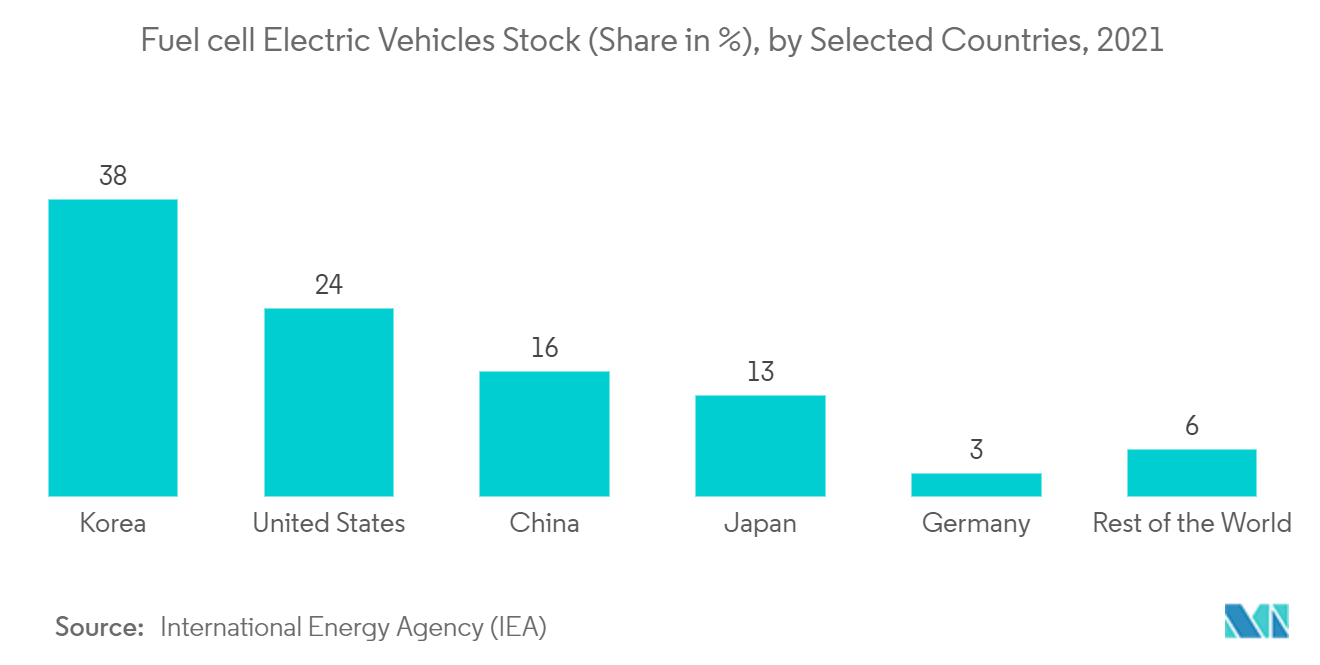
The Asia-Pacific is Expected to Dominate the Market
- The Asia-Pacific is one of the promising regional markets for polymer electrolyte membrane fuel cells due to favorable government policies for clean energy usage in countries such as China, Japan, and South Korea.
- China is considered to have the highest potential for PEMFC as the hydrogen fuel cell industry in the country has been gaining traction on the back of favorable national and provincial government subsidies and incentive programs from local authorities, mainly to encourage the uptake of hydrogen vehicles to cut pollution.
- Along with the potentially large market, China has numerous domestic enterprises that manufacture PEMFC. Hence, the country's demand and domestic supply are present, further bolstering the growth of the market. Moreover, Chinese companies seek to build their electrolyzer manufacturing capacity to 1.5-2.5 GW in 2022 to supply domestic and overseas markets.
- Meanwhile, China has plans to manufacture 100,000 to 200,000 tonnes of renewable hydrogen annually and have a fleet of 50,000 hydrogen-fueled vehicles by 2025. China is currently the world's largest market for fuel-cell trucks and buses and the third-largest for fuel-cell electric vehicles (FCEVs).
- Recently, Indian Scientists have indigenously developed platinum-based electrocatalysts for fuel cells through an efficient procedure. This electrocatalyst showed comparable properties to the commercially available electrocatalyst and could enhance the lifetime of the fuel cell stack performance.
- Therefore, owing to the abovementioned factors, the Asia-Pacific is expected to dominate the market during the forecast period.
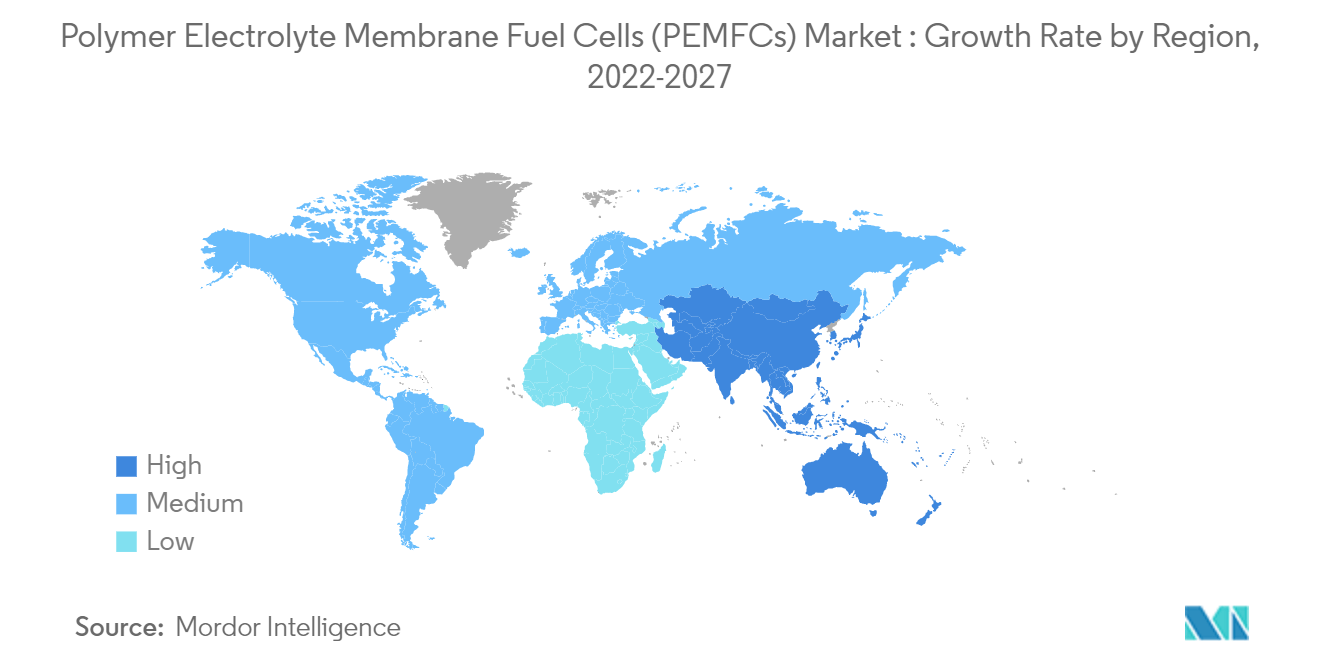
Competitive Landscape
The key players in the global polymer electrolyte membrane fuel cells market are consolidated. Some of the major players in the market (in no particular order) are Ballard Power Systems, Plug Power Inc., ITM Power PLC, PowerCell Sweden AB, and Intelligent Energy Limited, among others.
Polymer Electrolyte Membrane Fuel Cells (PEMFCs) Industry Leaders
-
Ballard Power Systems Inc.
-
Plug Power Inc.
-
ITM Power PLC
-
PowerCell Sweden AB
-
Intelligent Energy Limited
- *Disclaimer: Major Players sorted in no particular order
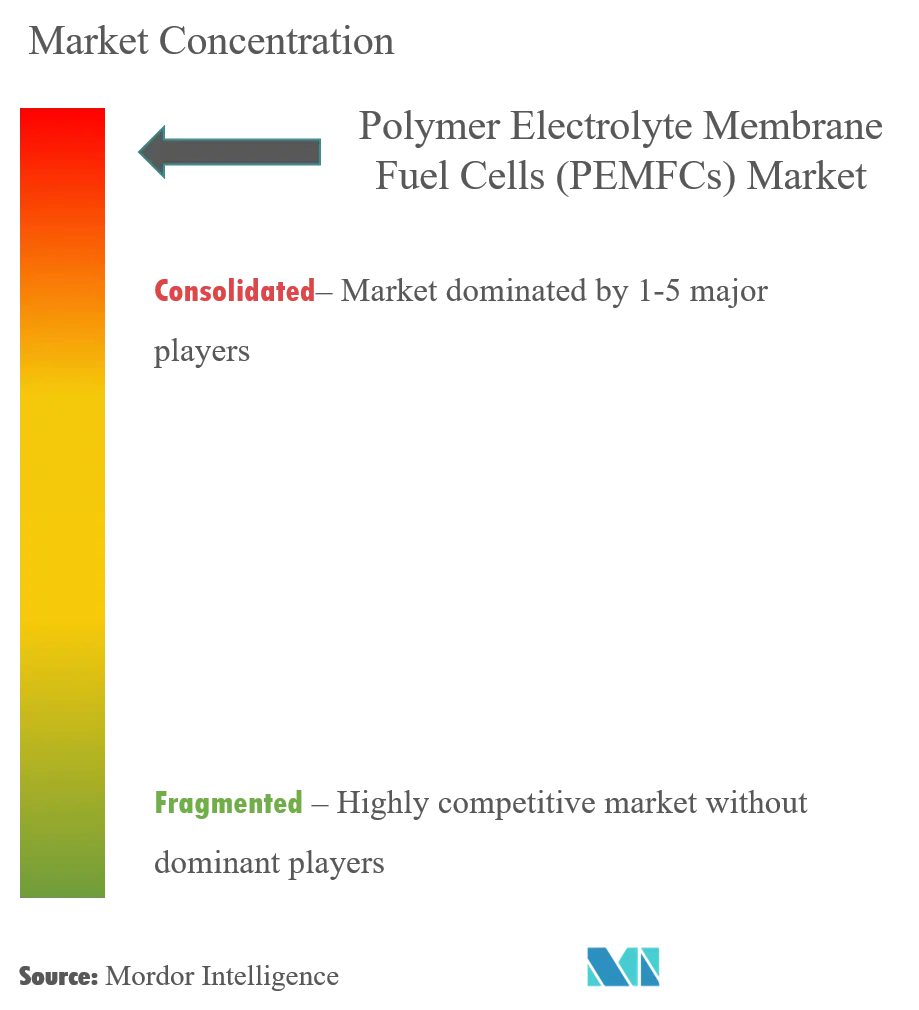
Recent Industry Developments
- August 2022: The National Renewable Energy Laboratory (NREL) began collaborating with Toyota Motor North America (Toyota) through a cooperative research and development agreement to build, install, and evaluate a 1-megawatt (MW) proton exchange membrane (PEM) fuel cell power generation system at NREL's Flatirons Campus.
- April 2022: A deal was signed by the German companies SFC Energy and FC TecNrgy to make fuel cells out of methanol and hydrogen in India. The company also announced the launch of the EFOY hydrogen fuel Cell in India, which is expected to play a significant role in meeting the country's hydrogen targets, including plans to produce up to 5 million tonnes of green hydrogen by 2030.
- October 2021: Panasonic Corporation announced that it had developed a pure hydrogen fuel cell generator, which generates power through a chemical reaction with high-purity hydrogen and oxygen in the air.
Global Polymer Electrolyte Membrane Fuel Cells (PEMFCs) Market Report Scope
Polymer electrolyte membrane fuel cells (PEMFCs) are developed for portable, stationary, and transportation applications. These fuel cells generate electricity and operate on the opposite principle of polymer electrolyte membrane electrolysis, which consumes electricity. Furthermore, PEM fuel cells are expected to replace the aging alkaline fuel cell technology in the space shuttle.
The polymer electrolyte membrane fuel cells (PEMFCs) market is segmented by geography (North America, Europe, Asia-Pacific, Rest of the World). The report offers the market size and forecasts in terms of revenue in USD billion for all the above segments.
| North America |
| Europe |
| Asia-Pacific |
| Rest of the World |
| By Geography | North America |
| Europe | |
| Asia-Pacific | |
| Rest of the World |
Key Questions Answered in the Report
How big is the Polymer Electrolyte Membrane Fuel Cells (PEMFCs) Market?
The Polymer Electrolyte Membrane Fuel Cells (PEMFCs) Market size is expected to reach USD 4.24 billion in 2025 and grow at a CAGR of 18.43% to reach USD 9.88 billion by 2030.
What is the current Polymer Electrolyte Membrane Fuel Cells (PEMFCs) Market size?
In 2025, the Polymer Electrolyte Membrane Fuel Cells (PEMFCs) Market size is expected to reach USD 4.24 billion.
Who are the key players in Polymer Electrolyte Membrane Fuel Cells (PEMFCs) Market?
Ballard Power Systems Inc., Plug Power Inc., ITM Power PLC, PowerCell Sweden AB and Intelligent Energy Limited are the major companies operating in the Polymer Electrolyte Membrane Fuel Cells (PEMFCs) Market.
Which is the fastest growing region in Polymer Electrolyte Membrane Fuel Cells (PEMFCs) Market?
Asia Pacific is estimated to grow at the highest CAGR over the forecast period (2025-2030).
Which region has the biggest share in Polymer Electrolyte Membrane Fuel Cells (PEMFCs) Market?
In 2025, the Asia Pacific accounts for the largest market share in Polymer Electrolyte Membrane Fuel Cells (PEMFCs) Market.
What years does this Polymer Electrolyte Membrane Fuel Cells (PEMFCs) Market cover, and what was the market size in 2024?
In 2024, the Polymer Electrolyte Membrane Fuel Cells (PEMFCs) Market size was estimated at USD 3.46 billion. The report covers the Polymer Electrolyte Membrane Fuel Cells (PEMFCs) Market historical market size for years: 2020, 2021, 2022, 2023 and 2024. The report also forecasts the Polymer Electrolyte Membrane Fuel Cells (PEMFCs) Market size for years: 2025, 2026, 2027, 2028, 2029 and 2030.
Page last updated on:
Polymer Electrolyte Membrane Fuel Cells (PEMFCs) Market Report
Statistics for the 2025 Polymer Electrolyte Membrane Fuel Cells (PEMFCs) market share, size and revenue growth rate, created by Mordor Intelligence™ Industry Reports. Polymer Electrolyte Membrane Fuel Cells (PEMFCs) analysis includes a market forecast outlook for 2025 to 2030 and historical overview. Get a sample of this industry analysis as a free report PDF download.
